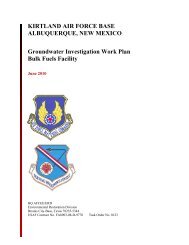Final FONSI and EA for hot cargo pad on Kirtland AFB - Kirtland Air ...
Final FONSI and EA for hot cargo pad on Kirtland AFB - Kirtland Air ...
Final FONSI and EA for hot cargo pad on Kirtland AFB - Kirtland Air ...
Create successful ePaper yourself
Turn your PDF publications into a flip-book with our unique Google optimized e-Paper software.
<str<strong>on</strong>g>Final</str<strong>on</strong>g> <str<strong>on</strong>g>EA</str<strong>on</strong>g> Addressing C<strong>on</strong>structi<strong>on</strong>, Operati<strong>on</strong>, <str<strong>on</strong>g>and</str<strong>on</strong>g> Maintenance of a Hot Cargo Pad<br />
Health <str<strong>on</strong>g>and</str<strong>on</strong>g> safety hazards can often be identified <str<strong>on</strong>g>and</str<strong>on</strong>g> reduced or eliminated. Necessary elements <str<strong>on</strong>g>for</str<strong>on</strong>g> an<br />
accident-pr<strong>on</strong>e situati<strong>on</strong> or envir<strong>on</strong>ment include the presence of the hazard itself together with the<br />
exposed (<str<strong>on</strong>g>and</str<strong>on</strong>g> possibly susceptible) populati<strong>on</strong>. The degree of exposure depends primarily <strong>on</strong> the<br />
proximity of the hazard to the populati<strong>on</strong>. Hazards include transportati<strong>on</strong>, maintenance <str<strong>on</strong>g>and</str<strong>on</strong>g> repair<br />
activities, <str<strong>on</strong>g>and</str<strong>on</strong>g> the creati<strong>on</strong> of noisy envir<strong>on</strong>ments or a potential fire hazard. The proper operati<strong>on</strong>,<br />
maintenance, <str<strong>on</strong>g>and</str<strong>on</strong>g> repair of vehicles <str<strong>on</strong>g>and</str<strong>on</strong>g> equipment carry important safety implicati<strong>on</strong>s. Any facility or<br />
human-use area with potential explosive or other rapid oxidati<strong>on</strong> process creates unsafe envir<strong>on</strong>ments due<br />
to noise or fire hazards <str<strong>on</strong>g>for</str<strong>on</strong>g> nearby populati<strong>on</strong>s. Noisy envir<strong>on</strong>ments can also mask verbal or mechanical<br />
warning signals such as sirens, bells, or horns.<br />
3.11.2 Existing C<strong>on</strong>diti<strong>on</strong>s<br />
C<strong>on</strong>tractor Safety. All c<strong>on</strong>tractors per<str<strong>on</strong>g>for</str<strong>on</strong>g>ming demoliti<strong>on</strong> <str<strong>on</strong>g>and</str<strong>on</strong>g> c<strong>on</strong>structi<strong>on</strong> activities are resp<strong>on</strong>sible <str<strong>on</strong>g>for</str<strong>on</strong>g><br />
following Federal <str<strong>on</strong>g>and</str<strong>on</strong>g> State of New Mexico OSHA regulati<strong>on</strong>s <str<strong>on</strong>g>and</str<strong>on</strong>g> are required to c<strong>on</strong>duct demoliti<strong>on</strong><br />
<str<strong>on</strong>g>and</str<strong>on</strong>g> c<strong>on</strong>structi<strong>on</strong> activities in a manner that does not increase risk to workers or the public.<br />
New Mexico is <strong>on</strong>e of several states that administer their own occupati<strong>on</strong>al safety <str<strong>on</strong>g>and</str<strong>on</strong>g> health (OSH)<br />
program according to the provisi<strong>on</strong>s of the Federal Occupati<strong>on</strong>al Safety <str<strong>on</strong>g>and</str<strong>on</strong>g> Health Act of 1970, which<br />
permits a state to administer its own OSH program if it meets all of the Federal requirements regarding<br />
the program’s structure <str<strong>on</strong>g>and</str<strong>on</strong>g> operati<strong>on</strong>s. The New Mexico Occupati<strong>on</strong>al Health <str<strong>on</strong>g>and</str<strong>on</strong>g> Safety Bureau<br />
program has the resp<strong>on</strong>sibility of en<str<strong>on</strong>g>for</str<strong>on</strong>g>cing Occupati<strong>on</strong>al Health <str<strong>on</strong>g>and</str<strong>on</strong>g> Safety Regulati<strong>on</strong>s within New<br />
Mexico. Its jurisdicti<strong>on</strong> includes all private <str<strong>on</strong>g>and</str<strong>on</strong>g> public entities such as city, county, <str<strong>on</strong>g>and</str<strong>on</strong>g> state government<br />
employees. Federal employees are excluded as they are covered by Federal OSHA regulati<strong>on</strong>s.<br />
OSH programs address the health <str<strong>on</strong>g>and</str<strong>on</strong>g> safety of people at work. OSH regulati<strong>on</strong>s cover potential<br />
exposure to a wide range of chemical, physical, biological, <str<strong>on</strong>g>and</str<strong>on</strong>g> erg<strong>on</strong>omic stressors. The regulati<strong>on</strong>s are<br />
designed to c<strong>on</strong>trol these hazards by eliminating exposure to the hazards via administrative or engineering<br />
c<strong>on</strong>trols, substituti<strong>on</strong>, or use of PPE. Occupati<strong>on</strong>al health <str<strong>on</strong>g>and</str<strong>on</strong>g> safety is the resp<strong>on</strong>sibility of each<br />
employer, as applicable. Employer resp<strong>on</strong>sibilities are to review potentially hazardous workplace<br />
c<strong>on</strong>diti<strong>on</strong>s; m<strong>on</strong>itor exposure to workplace chemical (e.g., asbestos, lead, hazardous substances), physical<br />
(e.g., noise propagati<strong>on</strong>, falls), biological (e.g., infectious waste, wildlife, pois<strong>on</strong>ous plants) agents, <str<strong>on</strong>g>and</str<strong>on</strong>g><br />
erg<strong>on</strong>omic stressors; recommend <str<strong>on</strong>g>and</str<strong>on</strong>g> evaluate c<strong>on</strong>trols (e.g., preventi<strong>on</strong>, administrative, engineering,<br />
PPE) to ensure exposure to pers<strong>on</strong>nel is eliminated or adequately c<strong>on</strong>trolled; <str<strong>on</strong>g>and</str<strong>on</strong>g> ensure a medical<br />
surveillance program is in place to per<str<strong>on</strong>g>for</str<strong>on</strong>g>m occupati<strong>on</strong>al health physicals <str<strong>on</strong>g>for</str<strong>on</strong>g> those workers subject to the<br />
use of respiratory protecti<strong>on</strong>, engaged in hazardous waste work, asbestos, lead, or other work requiring<br />
medical m<strong>on</strong>itoring.<br />
One ERP site, WP-26, is partially within the area of the Proposed Acti<strong>on</strong> <str<strong>on</strong>g>and</str<strong>on</strong>g>, as such, represents a<br />
potential exposure to c<strong>on</strong>tractor pers<strong>on</strong>nel. WP-26 c<strong>on</strong>sists of two ab<str<strong>on</strong>g>and</str<strong>on</strong>g><strong>on</strong>ed sewage lago<strong>on</strong>s that were<br />
used as settling p<strong>on</strong>ds <str<strong>on</strong>g>for</str<strong>on</strong>g> Kirtl<str<strong>on</strong>g>and</str<strong>on</strong>g> <strong>AFB</strong>’s residential <str<strong>on</strong>g>and</str<strong>on</strong>g> light industrial sewage system from 1962 to<br />
1987. Soil <str<strong>on</strong>g>and</str<strong>on</strong>g> groundwater sampling has identified both surface <str<strong>on</strong>g>and</str<strong>on</strong>g> subsurface media c<strong>on</strong>taminati<strong>on</strong> at<br />
WP-26. Specific c<strong>on</strong>taminates identified include TCE in subsurface soil vapor <str<strong>on</strong>g>and</str<strong>on</strong>g> perched groundwater,<br />
<str<strong>on</strong>g>and</str<strong>on</strong>g> various heavy metals <str<strong>on</strong>g>and</str<strong>on</strong>g> benzo(a)pyrene in surface sludge. Additi<strong>on</strong>ally, WP-26 might c<strong>on</strong>tain<br />
pathogens from sewage, such as tetanus <str<strong>on</strong>g>and</str<strong>on</strong>g> Hepatitis A. Exposure to any of these c<strong>on</strong>taminates or<br />
pathogens are potential health <str<strong>on</strong>g>and</str<strong>on</strong>g> safety c<strong>on</strong>cerns to c<strong>on</strong>tractors working <strong>on</strong> site. Further details<br />
regarding c<strong>on</strong>taminati<strong>on</strong> at WP-26 are presented in Secti<strong>on</strong> 3.10.2.<br />
Military Pers<strong>on</strong>nel Safety. Each branch of the military has its own policies <str<strong>on</strong>g>and</str<strong>on</strong>g> regulati<strong>on</strong>s that act to<br />
protect its workers, despite their work locati<strong>on</strong>. <strong>Air</strong> Force regulati<strong>on</strong> AFI 91-301, <strong>Air</strong> Force<br />
Occupati<strong>on</strong>al <str<strong>on</strong>g>and</str<strong>on</strong>g> Envir<strong>on</strong>mental Safety, Fire Protecti<strong>on</strong>, <str<strong>on</strong>g>and</str<strong>on</strong>g> Health (AFOSH) Program, which<br />
implements AFPD 91-3, Occupati<strong>on</strong>al Safety <str<strong>on</strong>g>and</str<strong>on</strong>g> Health, governs the recogniti<strong>on</strong>, evaluati<strong>on</strong>, c<strong>on</strong>trol,<br />
Kirtl<str<strong>on</strong>g>and</str<strong>on</strong>g> <strong>AFB</strong>, NM January 2011<br />
3-36
















